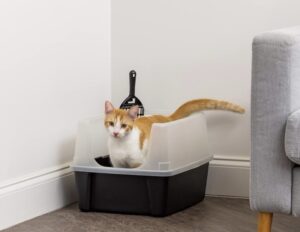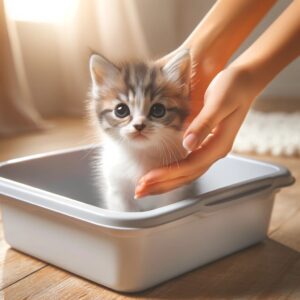
Welcoming a cat into your home is a joyous occasion, but it comes with its fair share of responsibilities, one of which is litter box training. Many cat owners find themselves perplexed at the prospect of teaching their feline companions this essential habit. “From Clueless to Clean: How to Train Your Cat to Use a Litter Box Effortlessly” is here to demystify this process. This article is not just about ensuring your cat uses the litter box; it’s about creating a harmonious living environment where your cat feels comfortable and you can enjoy a clean, odor-free home. Whether you’re a first-time cat owner or facing challenges with an older cat, this guide will provide you with step-by-step instructions, tips, and solutions to make litter box training a smooth, stress-free experience for both you and your furry friend.
Understanding Cat Behavior and Litter Box Training Basics
Cats are creatures of habit and cleanliness, and understanding their behavior is crucial to successful litter box training. In the wild, cats instinctively bury their waste to avoid attracting predators or rivals. This natural inclination makes litter box training relatively easier compared to other pets. However, knowing how to leverage this instinct is key.
Natural Instincts and the Comfort Zone: Cats prefer a clean, quiet, and safe space for their bathroom needs. They are sensitive to smells and textures, which influences their acceptance of a litter box. Observing your cat’s behavior, such as where they prefer to relax or hide, can give insights into the ideal placement of the litter box.
Creating a Stress-Free Environment: Stress can significantly affect a cat’s litter box usage. Changes in the environment, such as moving to a new home, new people or pets, or even a new litter box, can disrupt their routine. Maintaining a calm environment and a consistent routine helps in easing them into litter box training.
The Right Introduction: Introduce the litter box to your cat as soon as they enter their new home. Young kittens typically start using the litter box at around four weeks of age. Place them gently in the litter box after meals and naps. For older cats, it’s important to give them time to explore and discover the litter box on their own.
Litter Box Hygiene: Cats might refuse to use a litter box if it’s not clean. It’s essential to scoop the litter box daily and change the litter regularly. Unscented litter typically works best, as strong fragrances can deter cats from using the box.
Observation and Patience: Every cat has its personality and pace of learning. Some might take to the litter box immediately, while others require more time and encouragement. Observe their preferences in litter material and box type. Patience and gentle encouragement are vital during this training phase.

Choosing the Right Litter Box and Location
Selecting the right litter box and its placement is crucial in training your cat. An excellent choice to consider is the IRIS USA Open Top Cat Litter Tray, which offers a blend of comfort and convenience. Let’s delve into why this litter box is a standout option and how to find the ideal spot for it in your home.
Why the IRIS USA Open Top Cat Litter Tray Stands Out
- Open Design for Easy Access: The IRIS Litter Tray’s open-top design invites cats who might feel confined in enclosed boxes. It ensures comfort and ease of use for cats of all sizes.
- Effective Scatter Shield: A major highlight is its tall scatter shield, which helps keep the litter contained. The IRIS Litter Tray with Scatter Shield minimizes mess, making maintenance easier.
- Durability and Simple Cleaning: Durability is key, and this litter tray is built to last. The ease of cleaning the Sturdy IRIS USA Litter Tray ensures hygiene and simplicity in upkeep.
Optimal Location for the Litter Box:
- Seek Quietness and Privacy: Cats prefer a serene and secluded area for their litter box. Avoid noisy or busy areas in your home.
- Ensure Accessibility: The litter box, like the Easily Accessible IRIS Litter Tray, should be in a spot that your cat can easily reach at any time.
- Separate from Eating Areas: Keep the litter box distinct from where your cat eats and drinks.
- Consider Multiple Boxes for Multi-Story Homes: In larger homes, having a litter box on each level, such as placing an IRIS Litter Tray on Each Floor, can be very effective.
By selecting a user-friendly litter box like the IRIS USA Open Top Cat Litter Tray and positioning it thoughtfully, you set the stage for successful litter box training. The next section of our guide will provide a comprehensive step-by-step approach to litter training your cat.

Step-by-Step Guide to Litter Training Your Cat
Litter training your cat is a crucial step in pet ownership. With patience and the right approach, it can be a straightforward process. Here’s a simple guide to help you through this journey.
- Initial Introduction to the Litter Box: Begin by introducing your cat to their litter box. Place them in it at key times, such as after meals or naps, so they start associating it with relieving themselves.
- Use of Positive Reinforcement: Cats respond well to positive reinforcement. Whenever your cat uses the litter box correctly, reward them with a treat or affection. This helps reinforce the desired behavior.
- Maintaining Cleanliness: Regularly clean the litter box to encourage its use. Cats are naturally clean animals and prefer a tidy area for their needs.
- Observe and Adapt to Your Cat’s Preferences: Each cat is unique. Pay attention to your cat’s behavior and preferences regarding litter types and box placement. Some might prefer a quieter location or a different type of litter.
- Be Patient: Some cats take to the litter box quickly, while others need more time. Patience is key. Avoid punishing your cat for accidents; gently guide them back to the litter box instead.
By understanding these steps, you’ll be well-equipped to train your cat effectively. Remember, the right litter box, like the IRIS USA Open Top Cat Litter Tray, can make a significant difference in this process.
In the upcoming section, we’ll explore common challenges in litter training and offer practical solutions to tackle them.

Common Challenges and Solutions in Litter Training
Litter training a cat can be like a dance of two steps forward, one step back. As a cat owner myself, I’ve experienced the ups and downs of this process. Let me share some common challenges and the solutions that worked for me and my cat, Whiskers.
Challenge 1: Avoidance of the Litter Box When Whiskers first came home, he was hesitant to use his new litter box. After observing him, I realized the box was too close to his feeding area. Cats instinctively avoid soiling near where they eat. Relocating the litter box to a quieter, more secluded spot made all the difference.
Solution: Always place the litter box in a quiet, private area, away from your cat’s feeding station.
Challenge 2: Accidents Outside the Box I remember waking up one morning to find that Whiskers had an accident on the carpet. It was frustrating, but getting angry wasn’t the solution. I learned that gentle redirection and patience were key. Each time Whiskers had an accident, I would clean it up thoroughly (to remove the scent) and then gently place him in the litter box.
Solution: Clean accidents promptly and guide your cat back to the litter box without anger or punishment.
Challenge 3: Preference for a Certain Type of Litter I initially used a clumping clay litter, but Whiskers didn’t seem to like it. After experimenting with different types, I discovered he preferred a finer, sand-like litter. It was a simple change, but it made him much more comfortable using his box.
Solution: Be open to trying different types of litter to find what your cat prefers.
Challenge 4: Litter Box Cleanliness Like most cats, Whiskers is fastidious about cleanliness. A dirty litter box was a no-go for him. I found that scooping the box daily and doing a deep clean every week kept him happy and using the box regularly.
Solution: Maintain a strict cleaning schedule for the litter box to ensure it’s always inviting for your cat.
Challenge 5: Stress and Environmental Changes When I moved to a new apartment, Whiskers stopped using his litter box. The change in environment had stressed him. I provided extra comfort and reassurance, kept his routine as consistent as possible, and placed familiar blankets around his litter area to help him adjust.
Solution: Minimize stress during environmental changes and maintain consistency to help your cat adapt.
Through trial, error, and a lot of patience, Whiskers and I navigated these challenges together. Remember, each cat is unique, and what works for one may not work for another. The key is to be observant, patient, and adaptable.

Maintaining Good Litter Box Habits Long-Term
Establishing good litter box habits in your cat is an achievement, but maintaining these habits is equally important for their well-being and your peace of mind. Here are some tips to ensure long-term success.
- Consistency is Key: Keep the litter box in the same location and maintain a regular cleaning schedule. Cats thrive on routine, and changing the location or slacking on cleanliness can cause confusion and setbacks.
- Monitor Litter Box Usage: Regularly observe your cat’s litter box habits. Changes in frequency or consistency of waste can indicate health issues. Early detection can prevent problems from escalating.
- Update the Litter Box as Needed: As your cat grows, their needs might change. A kitten’s litter box may be too small for an adult cat. Ensure the litter box suits their size and comfort as they age.
- Provide Multiple Boxes in Multi-Cat Households: If you have more than one cat, having multiple litter boxes is crucial. The general rule is one box per cat plus one extra. This reduces competition and stress among cats.
- Be Patient with Changes: Cats may take time to adjust to changes in their environment or routine. Whether it’s a new home, a new family member, or even a new brand of litter, be patient and give your cat time to adapt.
- Regular Veterinary Check-Ups: Regular check-ups can help identify any underlying health issues that might affect litter box habits. A clean bill of health ensures your cat continues using their litter box properly.
By following these steps, you can maintain a harmonious relationship with your cat, free from litter box woes. Remember, patience, observation, and adaptability are your best tools in ensuring your cat’s comfort and happiness.
Why is my cat not using the litter box anymore? Changes in litter box usage can be due to various reasons such as medical issues, stress, or dissatisfaction with the litter box itself. It’s important to first rule out any health problems by consulting a veterinarian. Then, consider factors like cleanliness of the box, type of litter used, and the box’s location.
How often should I clean the litter box? For the comfort of your cat and household hygiene, it’s recommended to scoop the litter box at least once a day and change the litter entirely every week or two, depending on the type of litter and the number of cats using it.
Can older cats be trained to use a litter box? Absolutely! Older cats can be trained, but it might require more patience. Ensure the litter box is easily accessible and comfortable for them, and be consistent with training and positive reinforcement.
What should I do if my cat has an accident outside the litter box? Clean the area thoroughly to remove any scent, which might attract them back to the same spot. Gently guide your cat to the litter box afterward. Understanding the reason behind the accident is also crucial in preventing future occurrences.
Is it necessary to have more than one litter box? In a multi-cat household, it’s generally advised to have one litter box per cat, plus one extra. This helps reduce competition and stress among cats, and provides alternatives if one box is not clean or accessible.
As an Amazon Associate we earn from qualifying purchases through some links in our articles.




